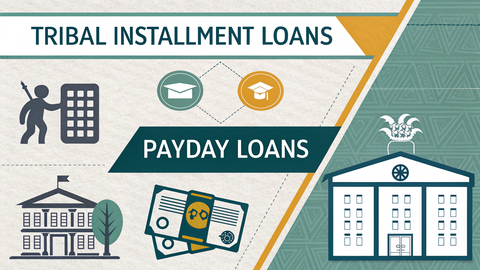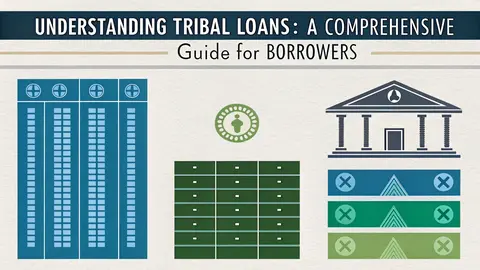Table of Contents
- Introduction
- Tribal Sovereignty and Lending Operations
- Federal Oversight and Regulations
- State Regulations and Tribal Lenders
- Legal Challenges and Court Decisions
- Tribal Lender Ownership Structures
- Consumer Protection Considerations
- Industry Self-Regulation
- Dispute Resolution and Jurisdiction
- Current Trends in Tribal Lending Regulation
- Key Considerations for Consumers
- Conclusion
Introduction
The landscape of tribal lending presents a complex intersection of Native American tribal sovereignty, federal regulations, state laws, and consumer protection considerations. For consumers considering tribal loans as a financing option, understanding this legal framework is essential to making informed decisions. This article aims to provide a comprehensive overview of the legal environment in which tribal lending operates, highlighting key aspects that consumers should be aware of before entering into agreements with tribal lenders.
Tribal lending has emerged as a significant sector within the alternative financial services industry, offering installment loans to consumers who may have limited access to traditional banking services. However, the unique legal status of tribal enterprises creates a regulatory environment that differs in important ways from that of mainstream financial institutions and state-licensed lenders. These differences have implications for loan terms, enforcement mechanisms, dispute resolution, and consumer rights.
Tribal Sovereignty and Lending Operations
Understanding Tribal Sovereignty
Tribal sovereignty refers to the inherent authority of federally recognized Native American tribes to govern themselves. This principle, established through treaties, court decisions, and federal legislation, allows tribes to operate as distinct political entities with powers of self-governance. The U.S. Supreme Court has described tribal sovereignty as "dependent sovereign nations," meaning tribes possess sovereign immunity but are ultimately subject to the plenary power of Congress.
Application to Lending Activities
Under tribal sovereignty, federally recognized tribes can establish economic development enterprises, including lending businesses, that operate under tribal law rather than state law. This allows tribal lenders to potentially offer loan products with terms that might not comply with individual state lending restrictions, particularly regarding interest rates and fees. These operations are typically authorized by tribal councils through ordinances or resolutions establishing the lending entity and its operational parameters.
Limits of Sovereign Immunity
While tribal sovereignty provides significant legal protections, it is not absolute:
- Congressional authority: Congress has the power to limit tribal sovereign immunity through explicit legislation.
- Tribal waivers: Tribes may voluntarily waive aspects of their sovereign immunity in certain agreements or contexts.
- Off-reservation activities: Courts have sometimes limited sovereign immunity protections for activities conducted primarily outside reservation boundaries.
- Arm-of-the-tribe analysis: Courts examine whether a lending entity genuinely functions as an extension of the tribe or merely uses tribal affiliation as a legal shield.
Federal Oversight and Regulations
Consumer Financial Protection Bureau (CFPB)
The CFPB has asserted authority to oversee tribal lending operations under federal consumer financial laws. While tribal sovereign immunity may shield tribes themselves from certain enforcement actions, the CFPB has taken the position that federal consumer protection laws apply to tribal lenders. The agency has initiated enforcement actions against tribal lending operations that allegedly engaged in unfair, deceptive, or abusive practices.
Federal Trade Commission (FTC)
The FTC has also been active in monitoring tribal lending practices:
- Unfair and deceptive practices: The FTC has pursued enforcement actions against tribal-affiliated lenders for alleged violations of the FTC Act's prohibitions against unfair or deceptive acts or practices.
- Operational partnerships: Particular attention has been given to arrangements where non-tribal entities play significant roles in tribal lending operations.
Key Federal Laws Affecting Tribal Lending
Several federal statutes apply to tribal lending activities:
- Truth in Lending Act (TILA): Requires accurate disclosure of loan terms and costs to consumers.
- Electronic Fund Transfer Act (EFTA): Regulates electronic payment authorizations and withdrawals.
- Fair Debt Collection Practices Act (FDCPA): Sets standards for debt collection activities, though tribal lenders may assert immunity from certain provisions.
- Military Lending Act: Provides special protections for active-duty service members, including a 36% APR cap on certain types of loans.
State Regulations and Tribal Lenders
The State Regulation Debate
One of the most contentious aspects of tribal lending involves the applicability of state lending laws to tribal operations. Tribal lenders generally maintain that state usury limits and licensing requirements do not apply to their operations due to tribal sovereign immunity. States, however, have frequently challenged this position, particularly when loans are made to residents outside tribal territories.
State Enforcement Actions
Several states have taken aggressive approaches to regulating tribal lending:
- Cease and desist orders: State regulators have issued orders demanding that tribal lenders stop offering loans to state residents without appropriate licenses.
- Lawsuits against lenders: Some states have filed suits directly challenging tribal lenders' immunity claims.
- Actions against service providers: States have also targeted payment processors, lead generators, and other service providers that support tribal lending operations.
Varying State Approaches
States differ considerably in their regulatory stances toward tribal lending:
- Restrictive states: Some states with strict usury limits or payday lending prohibitions have been particularly aggressive in opposing tribal lending to their residents.
- Accommodating states: Other states have taken less confrontational approaches, sometimes establishing specific regulatory frameworks for tribal lending entities.
- Cooperative agreements: In some cases, states and tribes have negotiated agreements regarding lending practices and regulatory compliance.
Legal Challenges and Court Decisions
Key Court Cases Shaping Tribal Lending
Several significant court decisions have helped define the legal boundaries of tribal lending operations. These cases have addressed fundamental questions about sovereign immunity, the scope of state regulatory authority, and the legal status of tribal business entities:
- Michigan v. Bay Mills Indian Community (2014): The Supreme Court reaffirmed tribal sovereign immunity for commercial activities, even those conducted outside reservation boundaries.
- California v. Miami Nation Enterprises (2016): The California Supreme Court established a multi-factor test for determining whether a business entity qualifies as an "arm of the tribe" entitled to sovereign immunity.
- CFPB v. Great Plains Lending (2019): The Ninth Circuit Court of Appeals ruled that tribal businesses are subject to investigation by the CFPB under the Consumer Financial Protection Act.
The "Arm of the Tribe" Doctrine
Courts have developed tests to determine whether a lending entity genuinely qualifies as an "arm of the tribe" entitled to share in tribal sovereign immunity. Factors typically considered include:
- Method of creation: Whether the entity was formed under tribal law and with tribal approval.
- Purpose: Whether the entity serves governmental purposes such as tribal economic development.
- Control: The degree of control the tribe exercises over the entity's operations and management.
- Financial relationship: Whether the tribe's finances would be affected by judgments against the entity.
- Intended benefit: Whether the entity's activities primarily benefit the tribe rather than outside parties.
Forum Selection and Arbitration Clauses
Courts have also addressed the enforceability of tribal loan agreement provisions that require:
- Dispute resolution in tribal courts: Some courts have declined to enforce tribal forum selection clauses, particularly when the tribal judicial system lacks independence or due process protections.
- Mandatory arbitration: Courts have scrutinized arbitration clauses that appear designed to deprive borrowers of substantive rights under federal law.
- Choice of law provisions: Clauses specifying that tribal law will govern disputes have faced challenges when they would effectively nullify state or federal consumer protections.
Tribal Lender Ownership Structures
Typical Ownership Models
Tribal lending operations employ various ownership and operational structures, which can have significant legal implications:
- Direct tribal ownership: Lending entities wholly owned and operated by tribal governments, often through economic development authorities or similar tribal instrumentalities.
- Vendor/service provider models: Arrangements where tribes partner with non-tribal companies that provide technological infrastructure, marketing, servicing, and other operational functions.
- Joint ventures: Formal business partnerships between tribes and outside investors or industry specialists.
Legal Scrutiny of "Rent-a-Tribe" Arrangements
Regulators and courts have scrutinized arrangements where tribes appear to have minimal involvement in lending operations:
- Economic reality tests: Courts look beyond formal legal structures to assess who truly controls operations and receives the majority of profits.
- Substantial tribal involvement: Arrangements where tribes have little operational control or receive only nominal financial benefits have faced successful legal challenges.
- Enforcement actions: Both federal and state authorities have targeted operations they characterize as "rent-a-tribe" schemes designed primarily to evade regulatory compliance.
Legitimate Tribal Economic Development
Many tribal lending operations represent legitimate tribal economic development efforts:
- Employment opportunities: These enterprises often create significant employment for tribal members.
- Revenue generation: Lending operations can provide substantial revenue streams for tribal governments and services.
- Self-determination: They represent an exercise of tribes' rights to develop their own economies and reduce dependency on federal funding.
Consumer Protection Considerations
Disclosure Requirements
Tribal lenders are generally subject to federal disclosure requirements, though compliance practices may vary:
- APR and finance charges: Federal law requires clear disclosure of annual percentage rates and total finance charges.
- Loan terms and conditions: Repayment schedules, late fees, and other key terms must be disclosed before loan consummation.
- Electronic disclosures: Since tribal lending is predominantly online, specific requirements apply to electronic disclosures and authorizations.
Collection Practices
Collection activities by tribal lenders raise particular legal questions:
- FDCPA applicability: Whether tribal lenders collecting their own debts are subject to the Fair Debt Collection Practices Act remains legally contested.
- Third-party collectors: Non-tribal collection agencies working on behalf of tribal lenders are generally subject to the FDCPA.
- Wage garnishment: The ability of tribal lenders to garnish wages without court orders has been challenged in various jurisdictions.
Access to Dispute Resolution
Consumer access to meaningful dispute resolution varies among tribal lenders:
- Tribal court systems: Quality, independence, and accessibility of tribal judicial systems differ substantially among tribes.
- Arbitration procedures: Some lenders require arbitration under procedures that may present practical or financial barriers for consumers.
- Waiver of class actions: Many tribal loan agreements include provisions prohibiting participation in class action lawsuits.
Industry Self-Regulation
Native American Financial Services Association (NAFSA)
NAFSA represents many tribal lenders and has established industry standards for member operations. This organization:
- Best practices: Provides a code of conduct for tribal lenders covering transparent disclosures, responsible lending, and fair collection practices.
- Compliance support: Offers resources to help member lenders meet federal regulatory requirements.
- Industry advocacy: Represents tribal lenders' interests in legislative and regulatory discussions.
Tribal Regulatory Bodies
Some tribes have established their own financial regulatory authorities:
- Tribal financial services commissions: Formal regulatory bodies established to oversee lending enterprises and ensure compliance with tribal regulations.
- Independent oversight: More sophisticated tribal regulatory frameworks include independent commissioners not directly involved in lending operations.
- Consumer complaint mechanisms: Some tribal regulatory systems include formal processes for addressing borrower complaints.
Variations in Standards
Self-regulatory practices vary widely among tribal lenders:
- Established lenders: Longer-operating tribal lending enterprises often have more developed compliance systems and consumer protection mechanisms.
- Tribal resource disparities: Larger tribes with more resources may have more sophisticated regulatory frameworks than smaller tribes.
- Non-affiliated operations: Some tribal lenders operate independently of industry associations and may follow different standards.
Dispute Resolution and Jurisdiction
Tribal Court Jurisdiction
Many tribal loan agreements specify that disputes must be resolved in tribal courts. This raises several considerations:
- Tribal court capacities: Tribal judicial systems vary greatly in their development, resources, and procedural safeguards.
- Physical accessibility: Tribal courts may be located in remote areas, making personal appearances impractical for non-local borrowers.
- Legal representation: Finding attorneys familiar with tribal court procedures can be challenging for consumers.
Arbitration Provisions
Alternatively, many tribal loan agreements require arbitration:
- Custom arbitration procedures: Some agreements establish unique arbitration frameworks rather than using established arbitration organizations.
- Cost considerations: Arbitration fees can be substantial and may create barriers for borrowers seeking to resolve disputes.
- Enforceability challenges: Courts have sometimes refused to enforce arbitration provisions they deem unconscionable or designed to deprive consumers of substantive rights.
Choice of Law Issues
The applicable law in tribal lending disputes is often contested:
- Tribal law application: Loan agreements typically specify that tribal law governs the transaction, potentially excluding state consumer protection statutes.
- Federal law intersection: Federal consumer protection laws may still apply regardless of choice of law provisions.
- Public policy exceptions: State courts sometimes refuse to enforce choice of law provisions that would violate strong public policy interests of the state.
Current Trends in Tribal Lending Regulation
Evolving Federal Approaches
Federal regulatory approaches to tribal lending continue to develop:
- CFPB enforcement priorities: The CFPB has increasingly focused on substance over form, looking at actual lending practices rather than tribal affiliations alone.
- True lender doctrines: Regulators have adopted approaches examining which entity is the "true lender" in arrangements involving tribal entities and non-tribal service providers.
- Small dollar lending rules: Broader federal regulations around small-dollar lending affect the tribal lending market, though implementation timelines have fluctuated.
State-Level Developments
States continue to refine their approaches to tribal lending:
- Rate cap legislation: More states have enacted interest rate caps that affect all small-dollar lenders operating in their jurisdictions.
- Bank partnerships: Some regulatory focus has shifted to "bank-model" lending, where lenders partner with banks to offer products in states with restrictive lending laws.
- Enforcement coordination: Increased coordination among state attorneys general has led to multi-state actions against certain lending operations.
Industry Evolution
The tribal lending industry itself is evolving in response to legal and regulatory pressures:
- Enhanced tribal control: Many tribes have increased their operational control and oversight of lending enterprises.
- Product diversification: Some tribal lenders have moved beyond short-term, high-interest products to offer more varied financial services.
- Compliance investments: Established tribal lenders have generally increased investments in compliance management systems and consumer protection measures.
Key Considerations for Consumers
Due Diligence Before Borrowing
Consumers considering tribal loans should conduct thorough research:
- Lender verification: Confirm the lender is genuinely tribally owned and operated, not merely using tribal affiliation as a legal shield.
- Regulatory status: Check if the lender belongs to industry associations like NAFSA that promote certain standards.
- Consumer reviews: Research other borrowers' experiences with the lender through review sites and consumer complaint databases.
- State restrictions: Determine whether your state has taken legal action against tribal lenders or enacted specific restrictions.
Understanding Loan Terms
Before accepting a tribal loan, carefully review all terms:
- Complete cost disclosure: Ensure you understand the APR, all fees, and the total cost of the loan over its full term.
- Repayment schedule: Confirm the frequency, amount, and number of payments required.
- Prepayment options: Check whether the loan can be repaid early without penalties and if doing so reduces the total interest paid.
- Default consequences: Understand what happens if you miss payments, including late fees, collection practices, and potential legal actions.
Awareness of Legal Protections
Consumers should know their rights and potential limitations:
- Federal protections: Understand that federal consumer protection laws like TILA should still apply regardless of tribal status.
- Dispute resolution challenges: Be aware that resolving disputes may be more complex than with state-licensed lenders due to jurisdiction and sovereign immunity issues.
- Complaint options: Know that complaints can still be filed with the CFPB, FTC, and state attorneys general, even if their enforcement authority may be contested.
Conclusion
The legal framework surrounding tribal lending represents a complex intersection of tribal sovereignty, federal regulation, state authority, and consumer protection principles. While tribal lending provides access to credit for consumers who may have limited alternatives, it also operates within a unique regulatory environment that differs from mainstream financial services.
For consumers, the key takeaway should be the importance of informed decision-making. Understanding the legal context of tribal lending—including both the protections that may apply and those that might be limited—is essential before entering into loan agreements. By conducting thorough research on potential lenders, carefully reviewing loan terms, and being aware of available resources for addressing concerns, consumers can make more educated choices about whether tribal loans are appropriate for their specific needs.
The legal landscape continues to evolve as courts address new challenges, federal agencies refine their approaches, and tribal lenders themselves adapt to changing expectations. This ongoing evolution underscores the importance of staying informed about current developments in this dynamic area of consumer finance.




